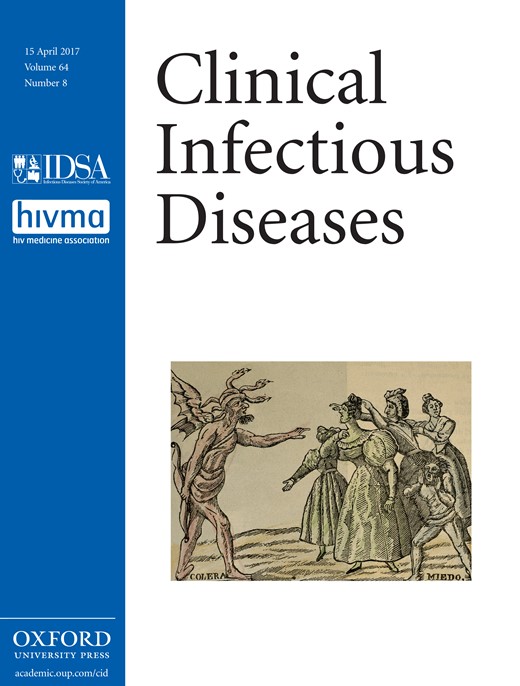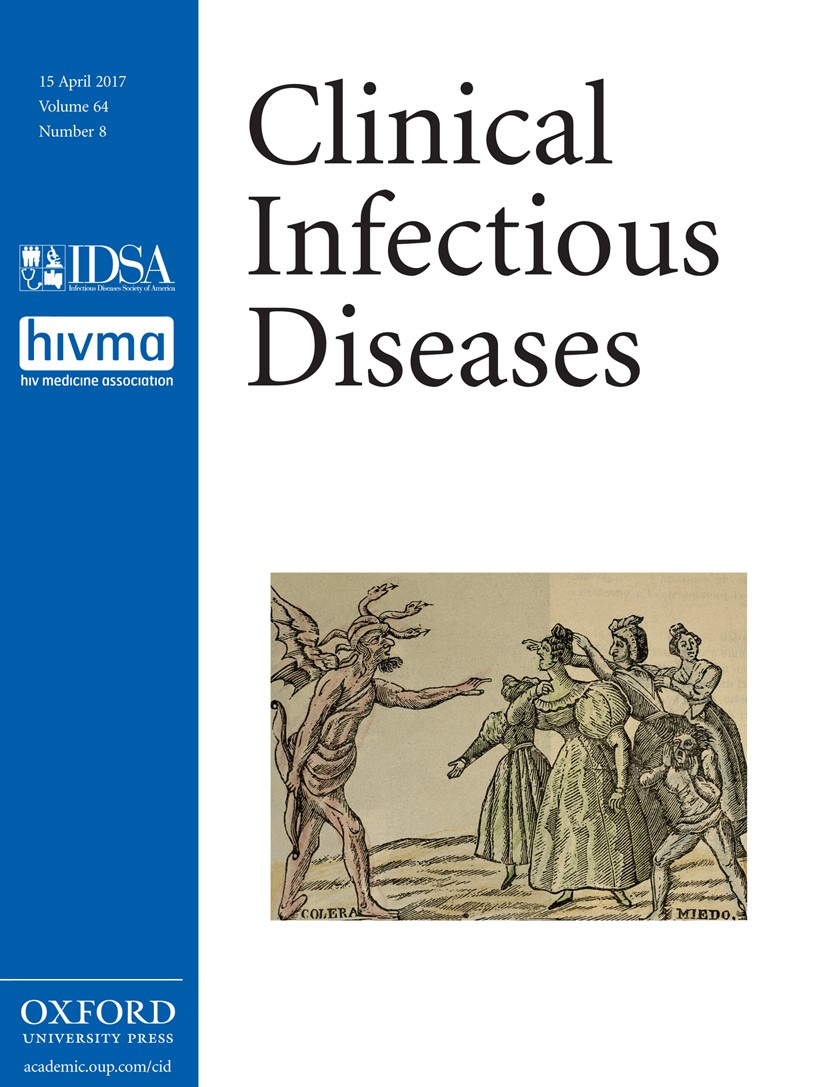
Cover image

Volume 64, Issue 8, 15 April 2017
NEWS
News
IN THE LITERATURE
In the Literature
ARTICLES AND COMMENTARIES
Management of Ventriculoperitoneal Shunt Infections in Adults: Analysis of Risk Factors Associated With Treatment Failure
Little is known regarding the optimal treatment of ventriculoperitoneal (VP) shunt infections in adults. VP shunt removal, particularly with a 2-stage replacement strategy when the patient is shunt dependent, remains the optimal choice of treatment and does not increase morbidity.
Effectiveness of Long-term Doxycycline Treatment and Cognitive-Behavioral Therapy on Fatigue Severity in Patients with Q Fever Fatigue Syndrome (Qure Study): A Randomized Controlled Trial
Cognitive-behavioral therapy is effective in reducing fatigue severity in patients with Q fever fatigue syndrome (QFS). Long-term treatment with doxycycline does not reduce fatigue severity in QFS patients compared to placebo and should not be advised.
Virological Outcomes of Second-line Protease Inhibitor–Based Treatment for Human Immunodeficiency Virus Type 1 in a High-Prevalence Rural South African Setting: A Competing-Risks Prospective Cohort Analysis
A community based, second-line treatment cohort of 102 subjects was followed monthly in community clinics with a total of 178 patient-years of follow-up; second-line virological failure was frequent in this setting.
Posttreatment Reactions After Single-Dose Diethylcarbamazine or Ivermectin in Subjects With Loa loa Infection
This study demonstrates that immune responses and side-effect profiles following diethylcarbamazine or ivermectin treatment of loiasis are similar. Changes in eosinophil counts and eosinophil activation posttreatment suggest that eosinophils play a key role in the posttreatment responses to both drugs.
Effect of Daptomycin Dose on the Outcome of Vancomycin-Resistant, Daptomycin-Susceptible Enterococcus faecium Bacteremia
Daptomycin displays a dose-dependent clinical response against vancomycin-resistant Enterococcus faecium bloodstream infection. A daptomycin dose of ≥9 mg/kg was associated with better patient survival than a dose of 7–9 mg/kg, followed by a dose of 6–7 mg/kg.
Sofosbuvir Plus Ribavirin Without Interferon for Treatment of Acute Hepatitis C Virus Infection in HIV-1–Infected Individuals: SWIFT-C
SWIFT-C is an open-label, 2-cohort clinical trial that is assessing the safety and efficacy of 12 weeks of sofosbuvir plus ribavirin for treatment of acute hepatitis C virus in human immunodeficiency virus–infected patients. The relapse rate was high (41%), suggesting a need for better therapeutic options.
Sulfadoxine-Pyrimethamine Exhibits Dose-Response Protection Against Adverse Birth Outcomes Related to Malaria and Sexually Transmitted and Reproductive Tract Infections
Compared to 0–1 dose of intermittent preventive treatment of malaria using sulfadoxine-pyrimethamine, ≥2 doses protects pregnant women against adverse birth outcomes attributable to malaria infection and to curable sexually transmitted and reproductive tract infections.
Quinolone Ear Drops After Tympanostomy Tubes and the Risk of Eardrum Perforation: A Retrospective Cohort Study
Despite the widespread use of quinolones ear drops, no studies have examined their adverse effect on the eardrum. Children receiving quinolone ear drops are 60% more likely to have eardrum perforations in comparison to those received neomycin ear drops.
Diffuse White Matter Signal Abnormalities on Magnetic Resonance Imaging Are Associated With Human Immunodeficiency Virus Type 1 Viral Escape in the Central Nervous System Among Patients With Neurological Symptoms
Among patients presenting with diverse neurological problems at a single center, cerebrospinal fluid discordance or escape was observed in 15% and was associated with diffuse white matter signal abnormalities on cranial magnetic resonance imaging.
Evaluation of the Clinical and Microbiological Response to Salmonella Paratyphi A Infection in the First Paratyphoid Human Challenge Model
The safe establishment of a protocol for a human challenge model for Salmonella Paratyphi A can be used to expedite the evaluation of novel vaccine candidates and provides insight into the clinical and immune response to paratyphoid infection.
Evaluation of Modified 2-Tiered Serodiagnostic Testing Algorithms for Early Lyme Disease
We evaluated 3 modified 2-tiered testing protocols for Lyme disease, which substitute noncomplex, objectively interpreted, inexpensive serologic assays for Western blotting. Compared with conventional 2-tiered testing, each modified protocol provided comparable or greater sensitivity in early disease and was comparably specific.
Low Efficacy of Antibiotics Against Staphylococcus aureus Airway Colonization in Ventilated Patients
Exposure of ventilated patients to antibiotics, often to several, does not efficiently reduce lower airway colonization by Staphylococcus aureus or progression to ventilator-associated tracheobronchitis or ventilator-associated pneumonia. Staphylococcus aureus competes with the normal respiratory flora during airway colonization.
Prevention of Staphylococcus aureus Ventilator-Associated Pneumonia: Conventional Antibiotics Won’t Cut It
High Rates of Transmission of Drug-resistant HIV in Aruba Resulting in Reduced Susceptibility to the WHO Recommended First-line Regimen in Nearly Half of Newly Diagnosed HIV-infected Patients
The prevalence of resistant HIV in Aruba has increased to alarming levels, compromising the WHO-recommended first-line regimen. As adequate surveillance as advocated by the WHO is limited, the Caribbean region could face an unidentified rise of NNRTI-resistant HIV.
Virus-driven Inflammation Is Associated With the Development of bNAbs in Spontaneous Controllers of HIV
The evolution of broadly neutralizing antibodies (bNAbs) in spontaneous controllers of HIV appears in the setting of low but persistent viral replication, in the absence of significant viral diversity, but in the presence of a unique inflammatory signature.
Clinical Status of Adolescents with Perinatal HIV at Transfer to Adult Care in the UK/Ireland
One-third of the UK/Ireland national pediatric HIV cohort has transferred to adult care. Three-quarters of adolescents were on ART at transfer, of whom 74% were virologically suppressed <400 cps/mL. The prevalence of triple class resistance was 12%.
Old Problems for New Providers: Managing the Postpediatric HIV Generation
Meningococcal Carriage Evaluation in Response to a Serogroup B Meningococcal Disease Outbreak and Mass Vaccination Campaign at a College—Rhode Island, 2015–2016
MenB-FHbp (factor H binding protein), a serogroup B meningococcal vaccine, was used to control a college outbreak. We investigated MenB-FHbp impact on nasopharyngeal meningococcal carriage, the primary source of meningococcal transmission. MenB-FHbp did not rapidly reduce meningococcal carriage or prevent serogroup B carriage acquisition.
BRIEF REPORTS
Electronic Consultations (E-consults): Advancing Infectious Disease Care in a Large Veterans Affairs Healthcare System
Declare the Past, Diagnose the Present, Foretell the Future: Electronic Consultations in Infectious Disease Practice
Pertussis Antibody Transfer to Preterm Neonates After Second- Versus Third-Trimester Maternal Immunization
PHOTO QUIZ
Upper Aerodigestive Tract Necrosis Due to Intranasal Hydrocodone-Acetaminophen Abuse
INVITED ARTICLE
CLINICAL PRACTICE
Eight Habits of Highly Effective Antimicrobial Stewardship Programs to Meet the Joint Commission Standards for Hospitals
The Joint Commission issued antimicrobial stewardship standards, consisting of 8 elements of performance, applicable to hospitals effective January 1, 2017. Little guidance exists on “how” to implement them. Real-world experience from established antimicrobial stewardship programs describes how hospitals can comply.



